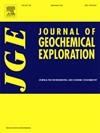Ore genesis and critical metal enrichment using deep learning algorithms in Gunga Pb-Zn deposit, Southern Pakistan: Constraints from sphalerite geochemistry and isotopic compositions
IF 3.3
2区 地球科学
Q1 GEOCHEMISTRY & GEOPHYSICS
引用次数: 0
Abstract
The Kirthar Fold and Thrust Belt in southern Pakistan is widely recognized as a major metallogenic province owing to the extensive presence of Pb-Zn deposits within the Jurassic sedimentary shelf sequence. One of these deposits, the Gunga Pb-Zn deposit, is a significant economic ore deposit situated within the Anjira Formation and comprises two mineralization zones, the Upper Mineralization Zone (UMZ) and Lower Mineralization Zone (LMZ). Despite the scarcity of documentation on the metallogenic source, origin, mineralization temperature, and other physicochemical conditions, our research is the first to explore the metallogenic differentiation and ore genesis of the deposit by examining minor and trace elements in sphalerite and isotopic analyses (S-Pb). The Gunga Pb-Zn deposit, amounting to 6.86 Mt. with 2.1 % and 11.4 % Pb and Zn, respectively, is linked to the interbedded limestone and shale unit of the Anjira Formation, and approximately below the depth of 200–250 m of the Jurassic-Cretaceous contact, the mineralization is believed to occur in the upper section of the Formation. Sphalerite is the dominant ore mineral, galena is a subordinate mineral, and pyrite is present in the main ore minerals. Sphalerite in the LMZ was found in a vein style, whereas it was disseminated in the UMZ and enriched in (medians) Ge (166 ppm), Cd (541 ppm), Pb (139 ppm), Ag (42 ppm), and Hg (68 ppm), lacking In (0.17 ppm), Co (6 ppm), and Mn (19). Based on trace element concentrations, the LMZ has a reduced environment, higher sulfur fugacity, and higher mineralization temperature (180–200 °C) than the UMZ, which has a lower mineralization temperature (130–180 °C). The presence of black shales, low temperatures, and high sulfur fugacity are the key parameters for Ge enrichment in the Gunga deposit. The δ34S values range from −10 to +5.6 ‰, suggesting that reduced sulfur was produced by both the BSR and TSR mechanisms, with basinal brines and seawater being the main sources of sulfur. The Pb isotope results suggest that the upper crust is the main source of the metals. In this study, Deep Learning algorithms based on sphalerite trace elements were employed for metallogenic discrimination of Pb-Zn deposits. The classifiers were trained on a dataset comprising approximately 3800 data points from 99 mineral deposits with published trace element compositions. The performance of the classifiers was assessed using a cross-validation with a k-fold variant. This study employed well-established classifiers on newly acquired geochemical data obtained from sphalerite samples collected from the Gunga Pb-Zn deposit. Based on the findings of this study, low temperature, lack of magmatic source elements, and clastic sedimentary sequence in a passive margin environment, a CD-type mineralization is proposed for the Gunga Pb-Zn deposit.
利用深度学习算法在巴基斯坦南部Gunga铅锌矿床的矿石成因和关键金属富集:来自闪锌矿地球化学和同位素组成的约束
由于侏罗纪陆架层序内广泛存在铅锌矿床,巴基斯坦南部的Kirthar褶皱和冲断带被广泛认为是一个重要的成矿省。其中,Gunga铅锌矿床位于Anjira组内,是一个重要的经济矿床,由上成矿带(UMZ)和下成矿带(LMZ)两个成矿带组成。在成矿来源、成因、成矿温度等物化条件文献匮乏的情况下,本研究首次通过闪锌矿微量元素检测和同位素(S-Pb)分析,探讨了矿床的成矿分异和矿床成因。贡加铅锌矿床的铅锌含量为6.86 mt,铅锌含量分别为2.1%和11.4%,与安吉拉组的灰岩和页岩互层单元相连,在侏罗—白垩系接触面200 ~ 250 m以下,认为成矿作用发生在安吉拉组上部。闪锌矿为主导矿物,方铅矿为次要矿物,黄铁矿为主要矿物。浅区闪锌矿呈脉状分布,浅区闪锌矿呈浸染状分布,富集(中值)Ge (166 ppm)、Cd (541 ppm)、Pb (139 ppm)、Ag (42 ppm)和Hg (68 ppm),缺乏in (0.17 ppm)、Co (6 ppm)和Mn(19)。从微量元素浓度来看,与矿化温度较低(130 ~ 180℃)的UMZ相比,LMZ具有还原环境、较高的硫逸度和较高的矿化温度(180 ~ 200℃)。黑色页岩的存在、低温和高硫逸度是Gunga矿床中Ge富集的关键参数。δ34S值在−10 ~ +5.6‰之间,表明BSR和TSR机制同时产生了还原硫,其中盆地盐水和海水是硫的主要来源。Pb同位素结果表明,上地壳是金属的主要来源。采用基于闪锌矿微量元素的深度学习算法进行铅锌矿床成矿判别。分类器是在一个数据集上训练的,该数据集包括来自99个矿床的大约3800个数据点,其中含有已公布的微量元素成分。分类器的性能通过k-fold变量的交叉验证进行评估。本文对冈嘎铅锌矿闪锌矿新获得的地球化学资料进行了分类。综合研究结果,结合低温、岩浆源元素缺乏、被动边缘环境碎屑沉积序等因素,认为冈嘎铅锌矿床为cd型成矿。
本文章由计算机程序翻译,如有差异,请以英文原文为准。
求助全文
约1分钟内获得全文
求助全文
来源期刊

Journal of Geochemical Exploration
地学-地球化学与地球物理
CiteScore
7.40
自引率
7.70%
发文量
148
审稿时长
8.1 months
期刊介绍:
Journal of Geochemical Exploration is mostly dedicated to publication of original studies in exploration and environmental geochemistry and related topics.
Contributions considered of prevalent interest for the journal include researches based on the application of innovative methods to:
define the genesis and the evolution of mineral deposits including transfer of elements in large-scale mineralized areas.
analyze complex systems at the boundaries between bio-geochemistry, metal transport and mineral accumulation.
evaluate effects of historical mining activities on the surface environment.
trace pollutant sources and define their fate and transport models in the near-surface and surface environments involving solid, fluid and aerial matrices.
assess and quantify natural and technogenic radioactivity in the environment.
determine geochemical anomalies and set baseline reference values using compositional data analysis, multivariate statistics and geo-spatial analysis.
assess the impacts of anthropogenic contamination on ecosystems and human health at local and regional scale to prioritize and classify risks through deterministic and stochastic approaches.
Papers dedicated to the presentation of newly developed methods in analytical geochemistry to be applied in the field or in laboratory are also within the topics of interest for the journal.
 求助内容:
求助内容: 应助结果提醒方式:
应助结果提醒方式:


